 |
||
|
||
| ||
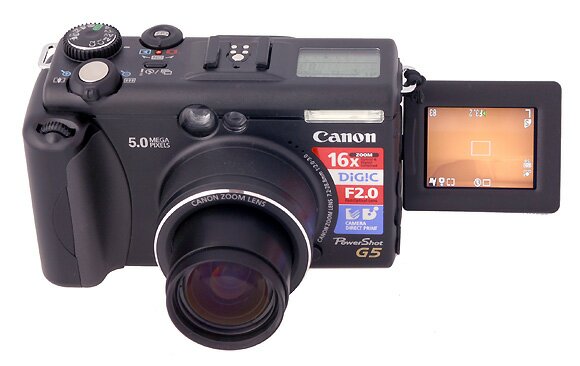 This is a new camera from Canon, with the design close to the G3 and with a 5Mp matrix. The matrix remains of the same size - 1/1.8" (7.2 X 5.3 mm). The increased number of pixels doesn't necessarily results in better visual quality. Since every pixel gets smaller, the requirements for the lens are higher. The reduced square also makes the camera less sensitive. Forced sensitivity increased noise. Nevertheless, it looks a successful solution, though I can't call it semiprofessional. It's like saying that Leiña is not a professional camera as it's not a reflex one. This camera is not small and it's comparable in dimensions with film rangefinder models. 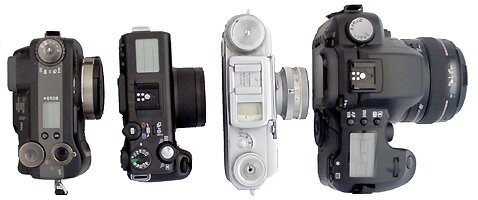 Photo: Casio QV4000, Canon G5, rangefinder film Kiev 4 and reflex Canon EOS ( in this case it is the digital D60, but in this respect the digital and film cameras of this series are almost identical). Although the camera is big enough and its size makes possible to arrange the viewfinder so that the lens mount doesn't overlap the frame at the minimal focal length, the designers didn't do that. This is probably an attempt to reduce parallax. But it looks a useless attempt because in the macro mode, when it becomes noticeable, it's better to use the LCD as a viewfinder. The 4x lens is enough for most tasks. You can use optical attachments. They can be mounted with a special transition ring with a bayonet mount. Such ring could have been supplied with the camera, but instead the latter comes with a decorative ring which is functionally useless but looks as complicated as a real ring. 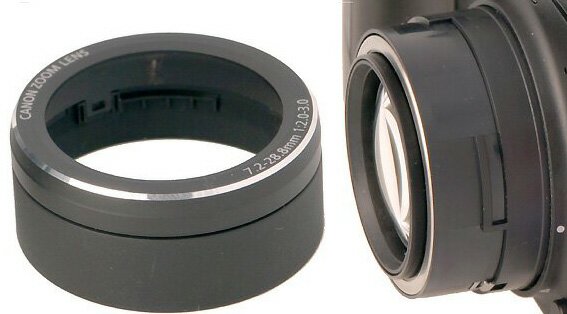 At least, a remote control is supplied. 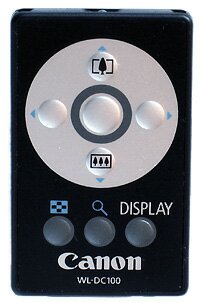 Information is displayed on the LCD located on top and on the rotating LCD which can also serve as a viewfinder. 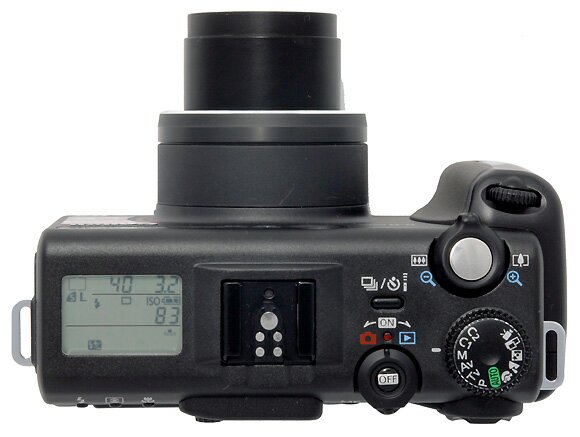
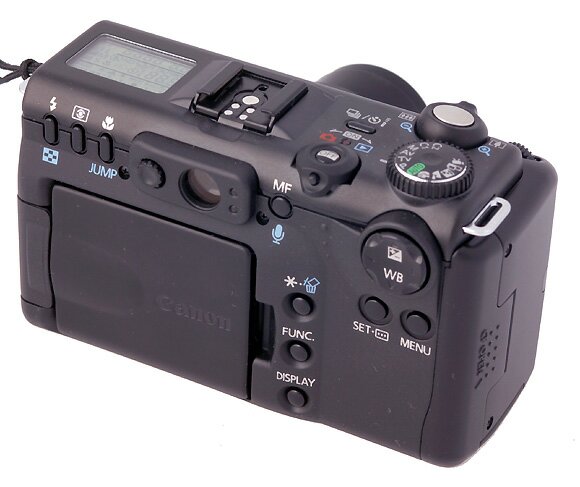 The camera takes power from the BP-511 Lithium-Ion Battery or from the power circuit via the adapter, which is also designed for charging the battery. 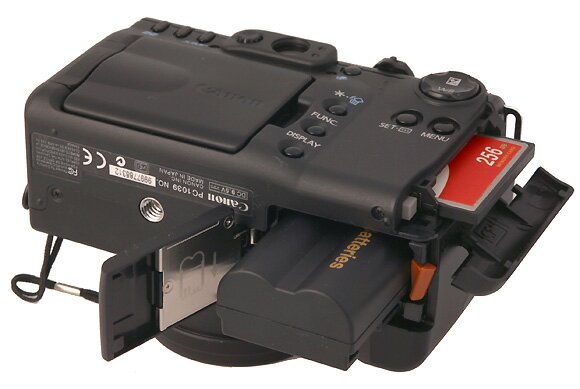 It connects to PC via USB. The camera also has a video-out. 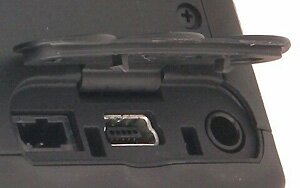 Connectors (right to left): power supply, USB, video. The software suite is standard. The versions got higher but there are no critical changes from those described in the previous review. The RAW Image Converter replaced File Viewer Utility quite a long time ago, and the EOS D30 was Canon's last supported camera regarding the Bibble program described in that review. MenuThe settings are traditionally rich.
There's a great deal of changeable settings. What's especially precious is that you can gradually shift the focusing square. Also, you can add voice comments to photos - it's not very important feature but sometimes it comes in handy. TestsThe color rendering and white balance are normal. The shot of the color table in the auto white balance mode and in the cloudy weather mode (which corresponded to the shooting conditions) look almost the same. The gray map remains gray on the shot.  Auto white balance.  White balance for cloudy weather. The gray scale remains gray at any brightness. 
 Above is the reduction of the scale. Zones 6,7,8 are enlarged below: 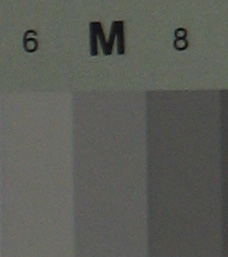 The shot's taken at ISO 50. The mean-square deviation from the average value of the pixels inside the zone can be considered a good noise measuring tool. For Zone 6: the average brightness is 106, the mean-square deviation is 1.76. For channels.
Now let's compare the resolution charts shot from the same distance, at the same sensitivity, exposure and aperture, but first comes the chart in the center then the one shifted to the upper right-hand corner. 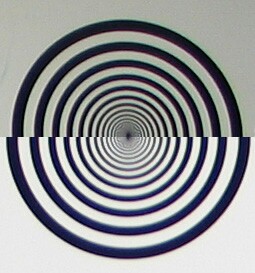 F = 7.2 mm, ISO 50, F:2, 1/40 s. The image is twice enlarged for the review. There's nothing unexpected, but all defects of the optical system are exposed. Distortion. The similarity between the image and the object is broken. The resolution chart size in the corner is smaller than in the center. Astigmatism. Horizontal and vertical lines can't be in focus at the same time. The effect is not strong in case of this lens. Illumination weakening to image edges. In the high-aperture lenses weakening of illumination near image edges is caused mostly by vignetting, and aperturing can smooth it over. At the focal length of F= 15.8 mm and aperture of F:2.5 the illumination weakens by 18%, at F:8 it falls down to 15%. Illumination is approximately proportional to the 4th power of cosine, that is why it's high for wide-angle lenses even without vignetting. In our case at the focal length of F=7.2 mm and covering power of 55 degrees the illumination weakens by 30%, which is considered a good result. I didn't carry out special experiments to measure illumination, the results are obtained from the shots taken for the resolution measurements, that is why certain irregularity of illumination is possible, and actual values can be just a bit better. Resolution - the circular resolution chart located in the corner lacks for one ring. Chromatic aberrations can also be noticed. The diagrams below show how brightness changes along the line that crosses two black strokes on the image edge to the left from the center:  Straight line is 41 pixels. Focal length F = 8 mm, aperture F:8. PhotosIn closing let me show you two photos taken in the good sunny weather.
Write a comment below. No registration needed!
|
Platform · Video · Multimedia · Mobile · Other || About us & Privacy policy · Twitter · Facebook Copyright © Byrds Research & Publishing, Ltd., 1997–2011. All rights reserved. | |||||||||||||||||||||||||||||||||||||||||||||||||||||||||||||||||||||||||||||||